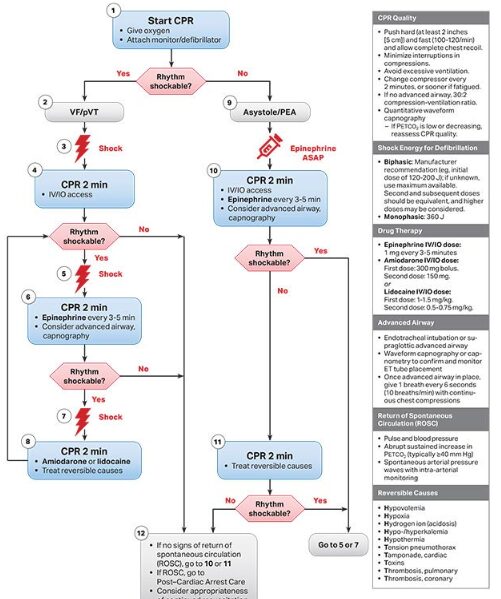Pediatric vs. Adult ACLS Cardiac Arrest Algorithms

Advanced Cardiovascular Life Support (ACLS) stands as a critical protocol in the world of emergency medical services. ACLS encompasses a series of evidence-based responses designed to increase survival rates during cardiac emergencies. This set of guidelines, continuously refined by the latest research. This emphasizes the importance of quick and efficient action.
Though this set of guidelines greatly helps during cardiac emergencies, it must be noted that not all individuals are the same. The younger patients require and respond differently to ACLS procedure as compared to adults. This blog explores the key differences and similarities between pediatric and adult ACLS cardiac arrest algorithms. Discover how these protocols adapt to offer optimal care for every age group.
Key Components of ACLS Algorithms
The core elements of ACLS algorithms form the backbone of effective cardiac arrest management.
- At the heart of these protocols is Cardiopulmonary Resuscitation (CPR). This crucial step ensures that blood continues to flow to vital organs.
- Early defibrillation is another cornerstone, especially critical in cases where the heart has entered a rhythm. This intervention has the potential to restart the heart’s effective rhythm.
- Advanced airway management also plays a pivotal role in both pediatric and adult ACLS algorithms. Ensuring that the airway is open and clear allows for adequate oxygenation.
Together, these key components: CPR, timely defibrillation, and proficient airway management—constitute the essential foundation upon which the success of ACLS interventions is built.
Understanding Pediatric ACLS Algorithm
The Pediatric ACLS algorithm is a specialized protocol designed to address the unique needs of infants and children experiencing cardiac arrest. This approach is tailored to the anatomical and physiological differences that distinguish younger patients from adults.
One of the critical aspects of the pediatric ACLS algorithm is the careful consideration of medication dosages. Unlike in adults, the dosages in pediatric cases are calculated based on the child’s weight. This precision ensures that the medications are effective without being harmful. This also takes into account the sensitivity of a child’s developing body to pharmaceutical interventions.
Furthermore, the pediatric ACLS algorithm places a strong emphasis on identifying and treating respiratory causes of arrest. In children, respiratory issues are a common precursor to cardiac arrest. This makes it essential to address these underlying problems promptly.
Lastly, the algorithm underscores the importance of considering developmental differences. Children’s bodies respond differently to stress and illness. Recognizing these differences is key to applying the pediatric ACLS algorithm effectively. This in turn ensures that each child receives the most appropriate care for their specific situation.
Understanding Adult ACLS Algorithm
The Adult ACLS algorithm serves as a critical guide for healthcare professionals managing cardiac arrest in adults. This algorithm is structured around the recognition and immediate treatment of sudden cardiac arrest.
Specific interventions that are more commonly utilized in adults include the administration of drugs like epinephrine and amiodarone. These drugs are important for keeping the heart’s rhythm steady which can increase the patient’s chances of survival. Moreover advanced airway tools are commonly employed to keep the air passage open and safe. This facilitates better oxygenation and ventilation during the resuscitation process.
The adult ACLS algorithm also involves utilizing monitoring and diagnostic equipment. This includes analyzing electrocardiograms (ECGs) to detect heart rhythms and administering treatments according to these results.
Key Differences Between Pediatric and Adult ACLS Algorithms
The Pediatric and Adult ACLS algorithms are tailored to address the distinct physiological characteristics and needs of their respective age groups. This differentiation is vital because age-related variations greatly affect the strategy for managing cardiac arrest.
- The ACLS algorithm for pediatric patients places a greater emphasis on addressing respiratory issues. This focus is reflected in the prioritization of airway management techniques, such as using appropriately sized airway devices.
Additionally, drug dosages in the pediatric algorithm are carefully calculated based on the child’s weight. This ensures efficacy while minimizing the risk of adverse effects.
- Conversely, the adult ACLS algorithm is more centered on the direct treatment of cardiac issues. There is a focus on defibrillation, which plays a crucial role in correcting life threatening irregular heartbeats commonly seen in adult cases of cardiac arrest.
In adult care specific medications like epinephrine and amiodarone are commonly used, with dosages tailored to suit the needs of adults.
By adjusting for these differences related to age, both ACLS protocols strive to enhance the chances of survival and recovery, for patients.
Similarities in Pediatric and Adult ACLS Algorithms
Both Pediatric and Adult ACLS algorithms share foundational similarities crucial to the management of cardiac arrest. In both algorithms, the emphasis on Cardiopulmonary Resuscitation is crucial. This fundamental step ensures the maintenance of vital blood flow to the brain and heart.
Additionally, both algorithms follow a structured sequence of actions. This starts from the initial assessment to the detailed management of airway, breathing, and circulation. This systematic approach ensures an efficient response to cardiac emergencies, maximizing the potential for positive outcomes across all age groups.
Conclusion
In this blog, we’ve explored the nuanced differences and inherent similarities of both ACLS cardiac arrest algorithms. Whether for a child or an adult, the algorithm emphasizes the importance of CPR, timely defibrillation and advanced airway management.
We highlighted both ACLS algorithm’s unique considerations, such as adjusted drug dosages and equipment sizes, alongside a focus on respiratory causes of arrest. The adult ACLS algorithm emphasizes on addressing cardiac causes, through the use of specific medications and advanced techniques.
Despite these differences, both algorithms share a commitment to the principles of rapid assessment and intervention. This comparative analysis underscores the critical need for healthcare providers to understand and apply these age-specific modifications, ensuring that every patient receives the most appropriate and effective care.
The ACLS cardiac arrest algorithm, whether tailored to pediatric or adult patients, exemplifies the medical community’s dedication to advancing care standards. Recognizing and adapting to the distinct needs of different age groups is vital. Healthcare professionals can maximize the chances of survival and recovery for all.






